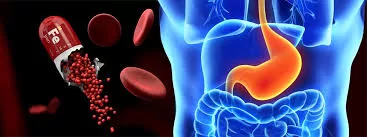Iron deficiency anaemia is a condition where blood lacks adequate, healthy red blood cells. Red blood cells carry oxygen from the lungs to tissues of the body. In iron deficiency anemia, iron is usually insufficient. Hence the body does not produce enough hemoglobin. A compound that binds oxygen to enable it to be transported in the blood. When it is not enough one tends to feel out of breath and tired. Easily corrected by the use of supplements.
Causes
- Blood loss e.g. heavy menstrual periods, peptic ulcers, and colorectal cancer can lead to the development of iron deficiency anemia.
- A poor diet that is low in iron. Iron can be gotten from food such as meat, eggs, and leafy green vegetables.
- Pregnancy- pregnant women’s iron stores serve themselves plus the growing fetus. Its thus important for them to take iron supplements to boost their iron level.
- Inability to absorb iron. It takes place in the small intestines. Diseases such as celiac disease can affect iron absorption.
Signs of iron deficiency anaemia
- Pale skin.
- Extreme fatigue.
- Chest pains.
- Dizziness.
- Cold feet and hands.
- Headaches.
- Body weakness.
- Inflammation of the tongue.
- Poor feeding in children.
- Unusual craving for dirt.
- Brittle nails.
Risk factors.
People who are at a higher risk of iron deficiency anaemia are:
- Women especially those who experience heavy menstrual periods.
- Frequent blood donors. Males should donate 4 times while females its 3 times a year when in good health.
- Infants and children mostly those born prematurely and are not breastfed.
- Vegetarians as meat is rich in iron.
Prevention of Iron deficiency anaemia
Iron deficiency can be avoided by choosing foods that are rich in iron. These include:
- Beans.
- Red meat.
- Leafy vegetables e. spinach.
- Seafood.
- Peas.
- Dry fruits like raisins.
- Iron-fortified cereals and pasta.

These are food that are rich in vitamin C which enhances iron absorption. Include:
- Tomatoes.
- Kiwi fruits.
- Broccoli.
- Melons.
- Tangerines.
- Grapefruit.
Complications.
- Heart problems as it may lead to an irregular or rapid heartbeat. The heart pumps more blood to compensate for the lack of oxygen in the blood when anaemic. This can lead to one having an enlarged heart or heart failure.
- Growth problems commonly in children and infants. Also increases susceptibility to infections.
- The problem in pregnancy. Severe iron deficiency is associated with low birth weight and premature births. Prevented by the use of iron supplements.
Diagnosis of Iron deficiency anaemia
- Blood tests where:
- Red blood cell size and color are checked. In this type of anaemia red blood cells tends to be smaller and paler in color.
- Haematocrit. The percentage of red blood cell volume in blood. Normal ranges are 35.5-44.9% in men and 38.3-48.6 % in women. Value changes depending on age.
- Haemoglobin. Low levels than normal indicate anemia. Normal values are 13.2- 16.6g/dl in men and 11.6- 15.0g/dl in women.
- Ferritin. Helps to store iron. Low ferritin levels indicate low iron levels.
- Colonoscopy- used to rule out lower intestinal bleeding sources. The colon and rectum are viewed by use of a thin tube that is flexible and has a camera.
- Endoscopy- check for any bleeding in the stomach. A thin lighted tube that has a camera is passed down through the stomach.
- Ultrasound is done to the pelvis. Shows the cause of excessive bleeding in menstrual periods e.g. uterine fibroids.
Treatment.
- Taking iron supplements.
- Consuming a diet that is rich in iron.
- Use of oral contraceptives to lighten heavy menstrual flow.
- Surgery to remove tumors or fibroids.
- Use of antibiotics to treat peptic ulcers.
- Mount Kenya University history, fees, courses
- Bay head elementary school history, enrolment, programs offered.
- Best Public High Schools in Kiambu County.
- Egerton university, fees, location, courses.
- List of Best private secondary schools in Nairobi County.
- Kenya Medical Training College, courses, requirements.
- Public Universities in Kenya